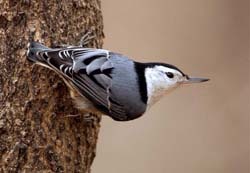Fun Facts About White Breasted Nuthatches

- A common feeder bird with clean black, gray, and white markings, White-breasted Nuthatches are active, agile little birds with an appetite for insects and large, meaty seeds.
- They get their common name from their habit of jamming large nuts and acorns into tree bark, then whacking them with their sharp bill to “hatch” out the seed from the inside.
- White-breasted Nuthatches may be small but their voices are loud, and often their insistent nasal yammering will lead you right to them.
- White-breasted Nuthatches are birds of mature woods, and they’re more often found in deciduous than coniferous forests (where Red-breasted Nuthatches are more likely). You can also find them at woodland edges and in open areas with large trees, such as parks, wooded suburbs, and yards.
- White-breasted Nuthatches forage up, down, and sideways over tree trunks and around large branches. They often (though not always) start high in trees and move down them head first, pausing to crane their necks up and back, toward the horizontal, for a look around. They probe into bark crevices or chip away at wood to find food. When they find large nuts and seeds, they jam them into the bark and hammer them open.
- White-breasted Nuthatches often store seeds and insects one at a time, and somewhat haphazardly, under loose bark on their territory. They typically hide the food by covering it with a piece of bark, lichen, moss, or snow.
- White-breasted Nuthatches live in pairs year round and chase other nuthatches from their territory. Agitated birds fan their tails, flick their wings, or raise the feathers of the back. A bird backing down from a confrontation typically raises its bill and tail, and droops its wings.
- In winter White-breasted Nuthatches join groups of chickadees, titmice, and woodpeckers to forage.
- The oldest known White-breasted Nuthatch was at least 9 years, 9 months old when it was found in Colorado in 1971

